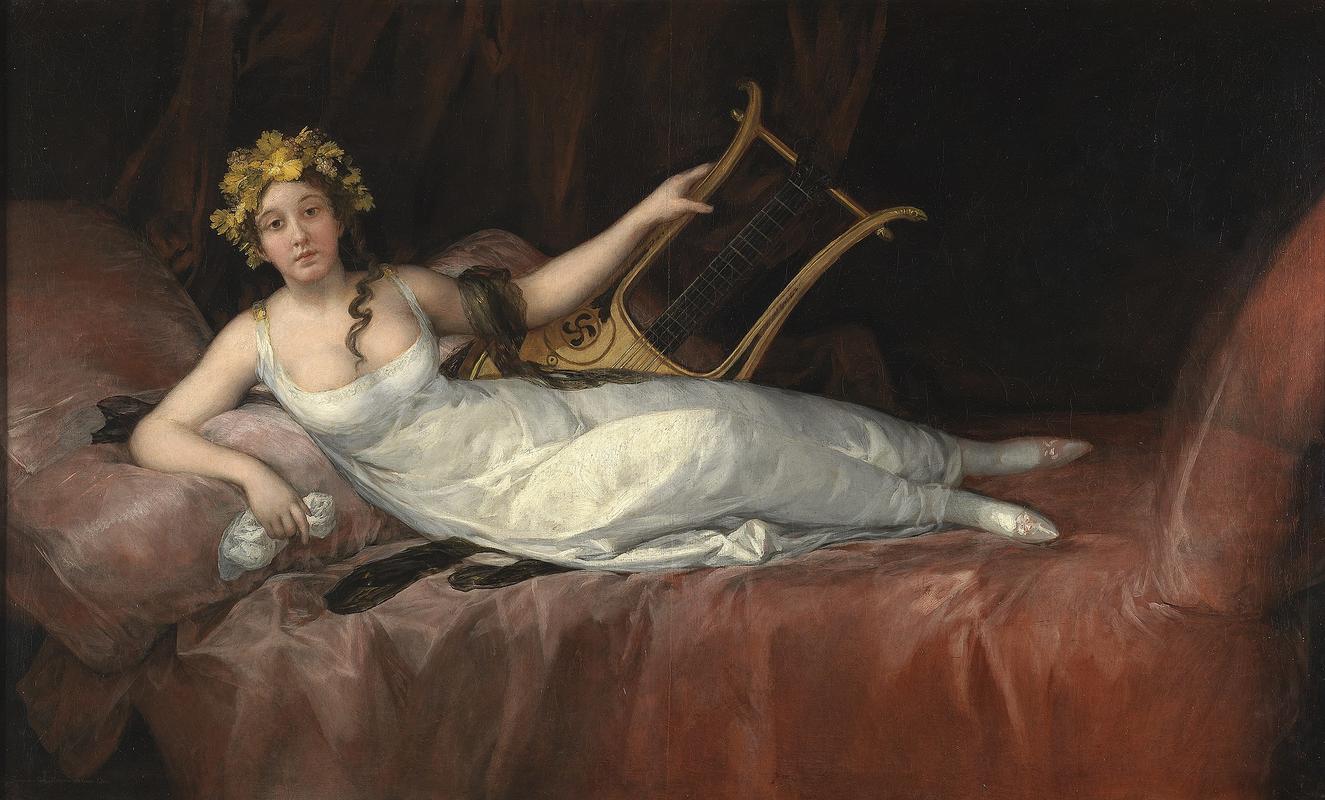More about The Marchioness of Santa Cruz

Sr. Contributor
This seemingly innocent portrait of the 21 year old Joaquina Téllez-Girón, Marquise of Santa Cruz by Francisco Goya, is full of sexual intrigue and Nazi secrets.
Sweetly known as “Grandma in a slip” by Joaquina’s grandchildren, the portrait was commissioned in 1805 by the Duchess of Osuna, aka the mother of the sitter, and was the second portrait painted by Goya of Doña Joaquina. Of course, the first was the family portrait The Dukes of Osuna and Their Children, painted when the girl was only 3, so the visage may have changed just a bit.
Alright, so that bit about sexual intrigue isn’t completely true. The painting isn’t “full of sexual intrigue” so much as it was very sexually intriguing for its time. Though the Marchioness is wearing a dress (not much of one by 17th Century standards) the painting’s composition is extremely deliberate in its similarity to the super naked depictions of Venus by Titian and Diego Velázquez, as well as Goya’s own pornographic piece The Nude Maja. She may have been a great lady married to José Gabriel de Silva y Walstein, the Marquis of Santa Cruz and the first director of the Prado, but here she is the bacchanal loving muse of art and poetry Erato (as indicated by the guitar and laurel wreath). Also, you can see Joaquina’s belly button through the muslin making her a total hussy.
As for the “Nazi secrets,” you may have figured out already that the Nazi Party wasn’t founded until 1920 and so unless it was added later (it wasn’t) that swastika looking thing painted on her guitar has nothing to do with Nazism. The symbol is actually something called a lauburu. Castilian for “four heads” the lauburu is a common Celtic symbol associated with the sun, male virility, and the duality of life and death, or man and woman. Try telling that to anyone around during WWII. The painting remained with the Marquis’ family until 1915 when it somehow ended up with the Marquis de Zahara and Maria Josefa de Silva. It was lost in 1928 after being displayed in the first retrospective of Goya’s work, wound up in London and eventually back in Spain with dictator Francisco Franco. Wanting to impress Hitler, Franco attempted to gift the piece to the Führer during the Meeting of Hendaye, maybe it wasn’t swastika-y enough, or perhaps Hitler was annoyed by all of Franco’s demands, but he turned down the painting as well as most of Franco’s proposed conditions for joining the Axis powers. The piece then went to the Valdes collection, sold again in 1980, and eventually made its way into the hands of the extremely English sounding Lord Wimborne. When Wimborne put the work up for auction in 1986 the Spanish government decided they’d had enough of dictators and British dudes caring for an artwork by one of Spain’s best of one of Spain’s most beautiful and filed a lawsuit stating that the work had been illegally exported. As a result the auction was called off but the Prado still had to raise $6 million to get the work back home.
Featured Content
Here is what Wikipedia says about Portrait of the Marchioness of Santa Cruz
The Portrait of the Marchioness of Santa Cruz or Portrait of the Marquise of Santa Cruz is an 1805 portrait by the Spanish artist Francisco José de Goya y Lucientes, a family friend of the subject. It has been owned by the Museo del Prado since 1986, when it bought it from its previous owner for over US$6 million.
It shows Joaquina Téllez-Girón, Marquise of Santa Cruz clad in a very light white dress, lying sideways on a red divan. Her head is decorated with yellow flowers; her left hand is balancing a lyre-guitar. Her gaze does not directly fix on the viewer but seems to look distant. Her body does not seem to sit in a natural position, but seemingly floats on the red divan and the pillows.
The theme seems almost allegorical, a reference to the ancient Greek theatre. The composition of the work is similar to Antonio Canova's sculpture of Paolina Borghese as Venus Victrix. The portrait is also similar to Diego Velázquez and, to an extent, to Titian's depictions of Venus. The flowers on her head are a reference to Bacchus, while the lyre-guitar with its resemblance to the ancient lyre is a homage to art and Apollo.
This painting inspired one pastiche or fantasy portrait depicted in the comedy film Mortdecai (2015), starring Johnny Depp and Gwyneth Paltrow.
Check out the full Wikipedia article about Portrait of the Marchioness of Santa Cruz












